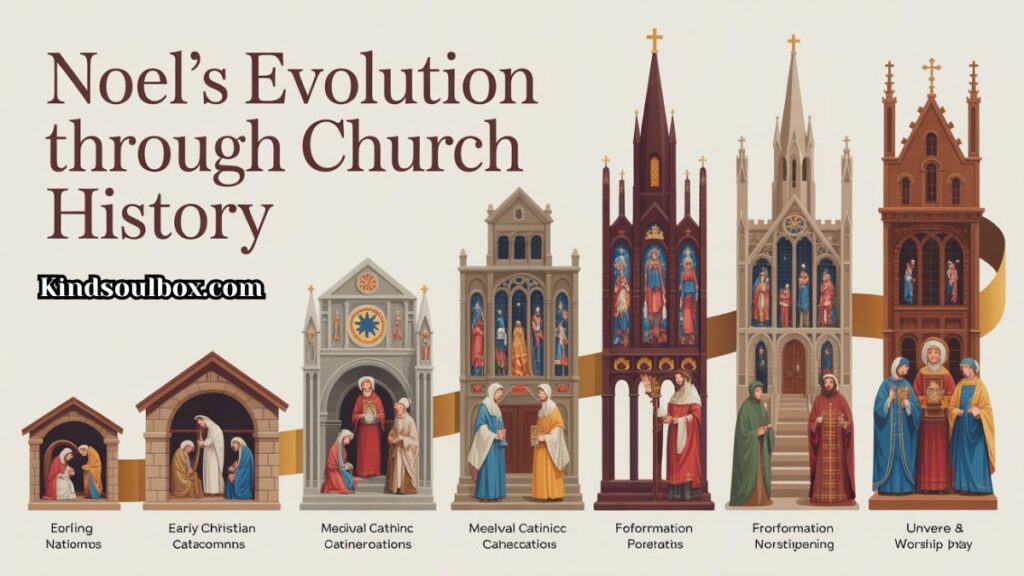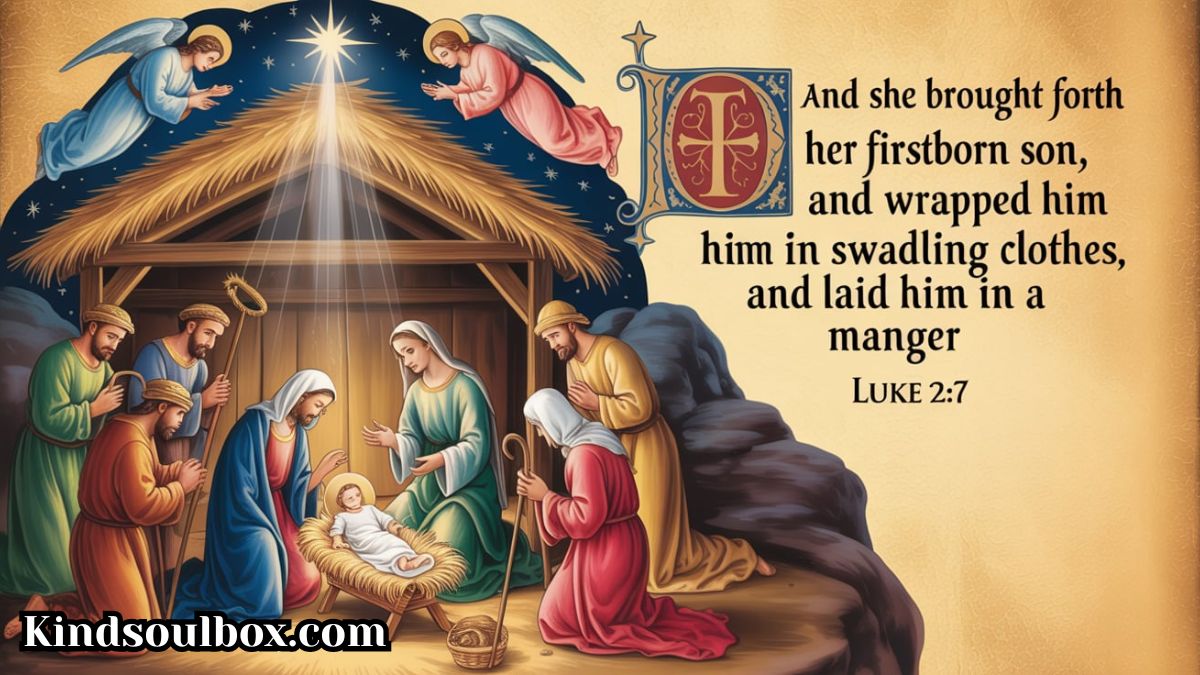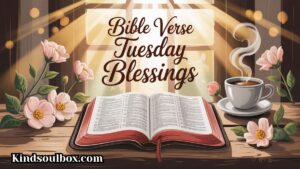Noel in the Bible verse represents a fascinating paradox—the term never appears in Scripture, yet it defines Christian tradition surrounding Christ’s birth. Derived from Latin natalis, meaning “birthday,” this French word captures the nativity’s essence without biblical presence.
Millions sing “The First Noel” during the holiday season without realizing this beloved Christmas carol contains zero biblical references. The word’s absence from Scripture makes its worship dominance remarkably intriguing.
Noel’s journey from medieval French cathedrals to global Christian communities reveals profound cultural exchanges. While biblical passages like Luke 2:10-11 use different terminology, “noel” perfectly encapsulates their celebratory spiritual reflection and joy.. Noel in the Bible Verse.
The Linguistic DNA of Noel: From Roman Roads to Cathedral Halls
The rich history of “noel” begins in ancient Rome. Long before Jesus Christ walked the Galilean hills, the Romans used natalis dies to mean “birthday.” The phrase literally translates as “day of birth.”
When Christianity spread across the Roman Empire, believers needed vernacular terms. Latin remained the ecclesiastical language, but common people required accessible words. French-speaking regions transformed natalis into nael, then noël by the 12th century.
Historical documentation proves this evolution. Manuscripts housed at the Bibliothèque Nationale de France show noël appearing in Christmas texts from 1175 AD. Troubadours carried these Christmas carols from village to cathedral, spreading the term across medieval Europe.
Why Romance Languages Embraced This Specific Term
The linguistic pattern reveals fascinating cultural heritage:
- Spanish: Navidad (from natividad)
- Italian: Natale (direct Latin descendant)
- Portuguese: Natal (same root as Italian)
- French: Noël (unique phonetic shift)
- English: Borrowed from the French Norman influence
Each language adapted the Latin foundation differently. French speakers added the dieresis (ë) to indicate separate vowel pronunciation. This small marking distinguished the sacred term from common words.
The Bible uses entirely different vocabulary. Greek New Testament manuscripts employ genesis (Matthew 1:18) and tikto (Luke 2:7) for birth events. Hebrew Scriptures use yalad (to bear) and moledet (nativity) when describing births.
Early Christians needed bridges between scriptural languages and daily speech. “Noel” became that bridge in French territories, eventually crossing the English Channel during the Norman conquest period.
Biblical Passages That Capture Noel’s Essence
While “noel” never appears in Scripture, specific passages embody its celebratory spiritual reflection. These verses form the theological foundation for why we sing “noel” with such joy.
Luke 2:10-11 – The Announcement That Changed Everything
“Fear not: for, behold, I bring you good tidings of great joy, which shall be to all people. For unto you is born this day in the city of David a Saviour, which is Christ the Lord.” (KJV)
Angel Gabriel’s proclamation contains every element Noel represents. The Greek word euangelion (gospel) carries connotations of victorious announcement. Ancient heralds shouted Euangelion when armies won battles or emperors fathered heirs.
This wasn’t quiet news whispered in corners. The birth of Jesus demanded celebration matching its cosmic significance. Shepherds received this divine incarnation announcement with appropriate fanfare—exactly what “noel” encapsulates in two syllables.
The shepherds’ response models no worship:
- Immediate departure to Bethlehem
- Verification of the miracle of the nativity
- Public proclamation spreading joy
- Glorifying and praising God
Medieval monks recognized this pattern. They chose “noel” for Christmas hymns because it captured the exuberant spirit Luke describes.
Isaiah 9:6 – The Prophetic Foundation
“For unto us a child is born, unto us a son is given: and the government shall be upon his shoulder: and his name shall be called Wonderful, Counsellor, The mighty God, The everlasting Father, The Prince of Peace.” (KJV)
Seven centuries before Bethlehem’s stable, Isaiah prophesied this nativity. The Hebrew phrasing emphasizes divine gift-giving. “Unto us” appears twice—God’s generosity demands recognition.
This verse appears in over 200 Christmas carols worldwide. Handel’s Messiah immortalized these words in music. “The First Noel” indirectly references this prophecy through its narrative of Magi following the star.
The profound meaning connects messianic expectation with fulfillment. Isaiah’s audience waited generations for this child. Their descendants sang these words during Advent preparations, building anticipation that exploded into “noel” celebration when Christ arrived.
Matthew 1:23 – Emmanuel’s Arrival
“Behold, a virgin shall be with child, and shall bring forth a son, and they shall call his name Emmanuel, which being interpreted is, God with us.” (KJV)
Six words define Noel’s theological core: “God with us.”
The incarnation doctrine—that deity became flesh—represents Christianity’s most radical claim. Eastern religions propose transcendent gods. Greek philosophers imagined distant, unmoved movers. Judaism emphasized God’s otherness and holiness.
Christ’s birth shattered these paradigms. God didn’t just visit; He relocated. Divine essence wrapped in human DNA. Infinite compressed into infant form.
Medieval theologians connected Matthew’s Emmanuel directly to the French noël. Both terms celebrate God’s proximity, not His distance. When congregations sing “noel,” they proclaim incarnational theology whether they recognize it or not.
John 1:14 – The Word Made Flesh
“And the Word was made flesh, and dwelt among us, (and we beheld his glory, the glory as of the only begotten of the Father,) full of grace and truth.” (KJV)
John’s Gospel approaches the Christmas story philosophically. Greek readers understood Logos (Word) as a cosmic organizing principle. Jewish audiences recognized Word as God’s creative power from Genesis 1.
John declares that both interpretations became human. The verb eskēnōsen (dwelt) literally means “pitched His tent” or “tabernacled.” God wasn’t touring humanity—He moved in permanently.
This passage explains why Eastern Orthodox and Western Catholic traditions both embraced “noel” terminology despite theological differences. The term transcends denominational boundaries because Christ’s birth unites all Christian communities.
Table: Biblical Passages and Noel Connections
| Scripture | Original Language | Noel Connection | Why It Matters |
|---|---|---|---|
| Luke 2:10-11 | Greek euangelion (gospel/good news) | Joyful announcement | Models celebratory worship response |
| Isaiah 9:6 | Hebrew yeled yullad (child is born) | Prophetic expectation | Links Old Testament hope to New Testament fulfillment |
| Matthew 1:23 | Hebrew Immanu El (God with us) | Incarnation theology | Emphasizes divine proximity, not distance |
| John 1:14 | Greek Logos (Word), sarx (flesh) | Philosophical depth | Bridges Greek thought and Hebrew revelation |
| Galatians 4:4 | Greek plērōma (fullness of time) | Divine timing | Explains why nativity celebration matters |
Galatians 4:4-5 – Timing and Purpose
“But when the fulness of the time was come, God sent forth his Son, made of a woman, made under the law, To redeem them that were under the law, that we might receive the adoption of sons.” (KJV)
Paul’s theological reflection explains the “why now?” question. God didn’t randomly select December 25th (more on that later). The nativity occurred when historical, political, and spiritual conditions aligned perfectly.
The “fullness of time” included:
- Roman roads enabled the rapid spread
- Greek language provides common communication
- Jewish diaspora establishing synagogues empire-wide
- Pax Romana created relative peace for missionary travel
- Prophetic timelines reaching completion
“Noel” celebrates this divine orchestration. The term implies not just birth, but a perfectly timed arrival. When we sing “The First Noel,” we’re acknowledging God’s meticulous planning across centuries.
The redemption arc from birth to cross gives Noel its spiritual meaning. We don’t celebrate a baby’s birthday like any other. We commemorate salvation’s entry point into human history.
Noel’s Evolution Through Church History

The journey from biblical events to “noel” terminology spans fascinating centuries. Understanding this rich history reveals how Christian tradition developed organically rather than through top-down mandates.
Early Church Silence: Why Christians Initially Ignored Christmas
First through third-century believers didn’t celebrate Christ’s birth. Archaeological evidence from Roman catacombs shows extensive Easter symbolism but zero nativity imagery before 300 AD.
Several factors explain this surprising omission:
- Pagan birthday concerns: Romans threw elaborate birthday parties for emperors and gods. Early Christians wanted a clear distinction from pagan practices.
- Martyrdom focus: With persecution rampant, Christian communities emphasized Christ’s death and resurrection more than His birth.
- Unknown birth date: The Gospels of Matthew and Luke never specify when Jesus was born. December 25th appears nowhere in Scripture.
- Jewish cultural influence: Judaism didn’t traditionally celebrate birthdays. First-century believers retained this perspective.
Clement of Alexandria (circa 200 AD) mentioned various theories about Christ’s birth date—May 20th, April 19th, November 17th—but showed no interest in celebrating any date.
This changed dramatically in the fourth century.
The December 25th Decision: Strategic Cultural Appropriation
Pope Julius I officially declared December 25th as Christmas in 336 AD. This wasn’t random selection or divine revelation. It was a calculated cultural exchange strategy.
December 25th already hosted major Roman festivals:
- Dies Natalis Solis Invicti (Birthday of the Unconquered Sun)
- Saturnalia celebrations concluding
- Winter solstice observances
Rather than fighting entrenched cultural patterns, church leadership redirected them. Romans accustomed to December festivities could now celebrate Christ instead of Sol Invictus.
Critics call this a compromise. Defenders call it missional wisdom. Regardless, this decision established the framework for “noel” to emerge as Christmas’s defining term in French-speaking regions.
The Latin natalis is perfectly suited to December 25th celebrations. As priests conducted Christmas Eve masses, they declared natalis Domini (birth of the Lord). French congregations shortened this to noël in vernacular speech.
Medieval France: Noel’s Golden Age
Twelfth through fifteenth-century France saw “noel” explode across creative expressions. Troubadours composed hundreds of noëls—simple, joyful songs in local dialects rather than church Latin.
These carols shared common characteristics:
- Refrain from structure with “Noël” repeated
- Narratives from Luke 2:1-20 and Matthew 2:1-12
- Folk melodies that commoners could easily learn
- Vernacular French instead of Latin
- References to Mary, the Angel Gabriel, the shepherds, and the Magi
Mystère de la Nativité plays brought biblical scenes to life. Village squares are transformed into a makeshift Bethlehem each December. Actors portrayed Mary and Joseph searching for lodging while audiences sang “noël” choruses.
Manuscript evidence from this period is extensive. The Bibliothèque Nationale preserves dozens of medieval carol collections. One 1423 manuscript contains 47 different noëls, each with regional variations.
The Burgundy region developed distinctive noel traditions:
- Incorporating bagpipes and hurdy-gurdies
- Adding dance movements to carols
- Creating noëls nouveaux (new noels) annually
- Competitive festivals judging the best compositions
This festive spirit established patterns still evident in modern French Christmas markets (marchés de Noël) and culinary traditions like bûche de Noël (Yule log cake).
“The First Noel”: Origins Uncovered
The most famous carol likely originated in Cornwall, England, during the 1600s. Oral tradition passed it through generations before anyone wrote it down.
Musicological analysis reveals fascinating details:
- Modal structure: Uses Dorian mode rather than major/minor keys, giving it archaic, timeless feel
- Narrative approach: Tells the Christmas story sequentially from the shepherds to the Magi
- Refrain power: “Noël, Noël, Noël, Noël” creates congregational participation moments
- Theological breadth: Covers Luke 1:26-38, Luke 2:1-20, and Matthew 2:1-12 in six verses
The first documented publication appeared in 1823 in William Sandys’ Christmas Carols Ancient and Modern. However, Sandys noted he collected it from “oral tradition in the west of England.”
The carol’s popularity exploded during Victorian England’s Christmas revival. Charles Dickens’ A Christmas Carol (1843) helped rehabilitate Christmas celebrations that Puritan influence had suppressed for centuries.
Today, “The First Noel” ranks among the five most-performed Christmas carols globally. Recordings span genres from classical to contemporary, gospel to jazz. Yet few singers realize they’re proclaiming a French loanword with profound meaning rooted in Latin nativity theology.
Theological Threads Connecting Noel to Scripture
Beyond historical linguistics, noel carries deep theological significance. The term encapsulates doctrines central to Christian tradition.
The Incarnation Principle: God’s Radical Humility
Philippians 2:6-8 describes Christ’s self-emptying (kenosis):
“Who, being in the form of God, thought it not robbery to be equal with God: But made himself of no reputation, and took upon him the form of a servant, and was made in the likeness of men: And being found in fashion as a man, he humbled himself, and became obedient unto death, even the death of the cross.”
“Noel” encapsulates divine humility in ways theological treatises struggle to express. When we sing this word, we’re celebrating God choosing vulnerability over invincibility, poverty over privilege, servanthood over sovereignty.
Mary’s Magnificat (Luke 1:46-55) previews this reversal theme:
- Mighty pulled down from thrones
- Humble exalted
- Hungry filled with good things
- Rich sent away empty
The nativity initiated these reversals. A feeding trough cradled the Bread of Life. A stable sheltered the Creator of stars. Shepherds—society’s outcasts—received premium seating at history’s most important birth announcement.
This is Noel’s theological genius. The term celebrates not just birth, but the specific kind of birth that reveals God’s character. Palaces would have contradicted the message. Bethlehem’s humble circumstances perfectly matched the incarnation’s purpose.
Angels’ Gloria: Heavenly Worship Mirrored on Earth
Luke 2:13-14 describes a multitude of angels suddenly appearing:
“And suddenly there was with the angel a multitude of the heavenly host praising God, and saying, Glory to God in the highest, and on earth peace, good will toward men.”
This wasn’t quiet contemplation. The Greek word plēthos (multitude) suggests overwhelming numbers. Stratias ouranios (heavenly host) carries military connotations—angelic armies mustering not for battle, but for worship.
The angels’ Gloria in Excelsis became Christianity’s liturgical template. Every mass incorporates this hymn. When medieval churches sang noëls, they were joining celestial worship that began that Judean night.
Joy dominates biblical birth narratives for this reason. The shepherds “returned, glorifying and praising God” (Luke 2:20). Magi “rejoiced with exceeding great joy” (Matthew 2:10). Even unborn John the Baptist “leaped for joy” in Elizabeth’s womb when Mary visited (Luke 1:44).
“Noel” captures this exuberant response. It’s not cerebral acknowledgment but visceral celebration. The word itself sounds joyful when sung—two syllables perfectly suited for musical repetition and crowd participation.
The Magi’s Worship Response: Gentile Inclusion Foreshadowed
Matthew 2:10-11 records the Magi’s reaction to finding Christ:
“When they saw the star, they rejoiced with exceeding great joy. And when they were come into the house, they saw the young child with Mary his mother, and fell down, and worshipped him: and when they had opened their treasures, they presented unto him gifts; gold, and frankincense, and myrrh.”
These Persian astrologers represent Gentile nations seeking God. Their journey prefigures global Christianity spreading beyond Jewish boundaries. Their gifts establish precedent for giving as worship expression.
“The First Noel” dedicates entire verses to these wise men. Their inclusion in the carol’s narrative isn’t accidental—it declares noel belongs to all nations, not just one ethnicity.
The gift-giving tradition rooted in this passage transformed holiday celebrations worldwide. Modern festive decorations, cards, and presents all trace back to the Magi, modeling generosity as an appropriate nativity response.
When we exchange gifts while singing “noel,” we’re participating in a two-thousand-year-old Christian tradition connecting material generosity with spiritual worship.
Cultural Metamorphosis: Noel Across Continents
The term’s journey from French cathedrals to a global phenomenon illustrates how cultural exchanges shape religious expression.
French Tradition: Regional Noel Variations
France developed rich regional noël traditions that survive today:
Burgundy: Known for noëls bourguignons featuring bagpipes (cornemuse) and local patois. These carols often included humorous elements and contemporary references, making biblical stories relatable to peasant audiences.
Provence: Developed pastoral traditions with elaborate nativity plays. Villages compete annually for best crèche (nativity scene) using santons (little saints)—hand-painted clay figurines representing Mary, Joseph, shepherds, and village characters.
Brittany: Breton noëls incorporated Celtic musical modes and themes of maritime protection. Fishing communities sang carols asking Christ for safe voyages and bountiful catches.
The culinary tradition of bûche de Noël originated from Yule log customs. Families would burn a log throughout Christmas Eve, saving a piece for next year’s fire. When urban apartments replaced hearths, French pastry chefs created edible versions—rolled sponge cakes decorated as logs.
Modern marchés de Noël (Christmas markets) continue medieval fair traditions. Strasbourg’s market, dating to 1570, attracts millions annually. Visitors sip vin chaud (mulled wine) while browsing festive decorations and singing carols—direct descendants of troubadour performances.
English Adoption: Victorian Revival and Class Distinctions
English speakers borrowed “noel” during the Norman conquest period (1066 onward). However, the term initially carried aristocratic associations while commoners used “Christmas.”
Charles Dickens’ A Christmas Carol (1843) democratized Christmas celebrations. His portrayal of the Cratchit family’s warmth and Scrooge’s redemption captured Victorian imagination. Within decades, Christmas transformed from a minor church observance to a major cultural event.
“Noel” gained popularity through carol revival movements. Composers like John Stainer and Ralph Vaughan Williams collected folk carols, publishing them for church choirs. “The First Noel” appeared in nearly every collection, spreading its French title throughout English-speaking congregations.
Class distinctions persisted: Upper classes preferred “Noel” for formal occasions while working classes said “Christmas” in daily speech. This linguistic divide appears in Victorian literature, where aristocratic characters exchange “Noel greetings” while servants say “Happy Christmas.”
American Reinvention: From Puritan Ban to Commercial Extravaganza
Colonial America’s Puritan influence initially banned Christmas celebrations. Massachusetts outlawed Christmas observance from 1659 to 1681, fining anyone caught celebrating.
The ban’s reasoning: No biblical command to celebrate Christ’s birth, plus concerns about pagan origins and rowdy behavior during festive seasons.
Irish and German immigrants during the 1800s reintroduced Christmas traditions. “The First Noel” entered American hymnals through Episcopal and Catholic churches, maintaining European connections.
The 20th century saw explosive commercialization. Department stores created elaborate window displays. Radio broadcasts popularized carols nationwide. Bing Crosby’s recordings brought “noel” into living rooms coast to coast.
Contemporary worship music now incorporates “noel” extensively. Artists like Chris Tomlin, Lauren Daigle, and Hillsong produce albums titled Noel or Emmanuel, connecting modern Christian communities with ancient tradition.
Global Expressions: How Different Cultures Embrace Noel
African churches adapt Noel traditions using indigenous instruments and rhythms. In Nigeria, carol services feature nativity songs in Yoruba, Igbo, and Hausa languages. The Christmas story gets retold with cultural contextualization—shepherds become cattle herders, Magi arrive as tribal chiefs.
Asian Christian communities navigate unique challenges. In the majority of non-Christian nations like Japan and South Korea, Christmas exists primarily as a commercial event. Christian communities there use “noel” carols as evangelistic tools, explaining Christ’s birth to curious observers.
Latin American nations maintain strong La Natividad traditions, blending indigenous customs with Catholic heritage. Las Posadas reenactments show Mary and Joseph seeking lodging, while communities sing villancicos (Spanish carols similar to French noëls).
This global diversity demonstrates Noel’s adaptability. The term transcends linguistic barriers because it celebrates universal human experiences: birth, joy, hope, and love.
Modern Faith Applications: Why Noel Still Matters
Understanding Noel’s rich history and theological depth transforms how contemporary believers engage with Christmas traditions.
Worship Setlists and Congregational Memory
Over 200 Christmas carols worldwide include “noel” in titles or lyrics. This ubiquity creates congregational memory that spans generations.
Research shows musical memory outlasts verbal memory. Alzheimer’s patients who’ve forgotten family names can still sing childhood hymns perfectly. “Noel” carols tap into this powerful cognitive mechanism.
Churches leveraging this principle:
- Program multi-generational carol services where the oldest and the youngest sing together
- Create liturgies incorporating “noel” refrains throughout Advent
- Use familiar melodies with updated theological lyrics, maintaining “noel” celebrations
The theological weight compressed into two syllables makes Noel ideal for worship. It’s simultaneously accessible to children and profound enough for theologians—embodying incarnational simplicity.
Advent Preparation: Refocusing Commercialized Seasons
The holiday season’s commercial pressures threaten to obscure the sacred origins. Malls play instrumental versions stripped of lyrics. Festive decorations emphasize nostalgia over nativity.
Families reclaiming spiritual focus through Noel practices:
Daily devotionals: Read one biblical verse from nativity accounts (Luke 1:26-38, Luke 2:1-20, Matthew 2:1-12) paired with historical noel carol verses
Countdown activities: Each day, study one phrase from “The First Noel,” connecting lyrics to Scripture passages
Service projects: Model Magi generosity through charitable giving, connecting material gifts with spiritual worship
These practices provide spiritual reflection opportunities that shopping and decorating don’t offer. They transform passive cultural participation into active faith expression.
Evangelistic Bridges: Familiar Language Opening Gospel Doors
“Noel” offers a unique evangelistic advantage—cultural familiarity without religious baggage. Even unchurched people know “The First Noel” melody and associate it with positive holiday emotions. Noel in the Bible Verse.
Churches using this strategically:
- Host community carol nights, explaining each song’s origin
- Create seeker-friendly services where carols lead into Christmas story presentations
- Train members to share Christ’s birth narrative using a familiar Noel framework
One pastor reports: “When I ask seekers about ‘The First Noel,’ everyone recognizes it. But when I explain what ‘noel’ means and show them Luke 2:10-11, they’re genuinely surprised. That opens conversations about why we celebrate.”
The term bridges secular and sacred in ways that explicitly religious language can’t. “Merry Christmas” triggers culture war associations. “Noel” feels neutral enough to avoid defensiveness while maintaining theological substance. Noel in the Bible Verse.
Common Misconceptions Debunked
Several myths about Noel persist despite historical evidence. Addressing these promotes an accurate understanding. Noel in the Bible Verse.
Misconception: “Noel Appears in Ancient Manuscripts”
Reality: No Hebrew, Aramaic, or Greek biblical manuscript contains “noel” or equivalent transliteration. Modern Bible translations avoid anachronism by using contextually appropriate terminology.
Some fringe groups claim Vulgate Latin contains noel, but it uses nativitas instead. The confusion stems from natalis (birthday) appearing in reference to Christ’s dies natalis (birthday)—but this isn’t the French “noel.”
Misconception: “It’s a Name Directly from Scripture”
Reality: Noel as a given name originated in medieval France, as babies born around Christmas received Noël or Noëlle (feminine). This naming practice reflects cultural tradition, not biblical precedent.
Scripture contains no character named Noel. The confusion sometimes arises from Emmanuel/Immanuel, which is biblical (Isaiah 7:14, Matthew 1:23), but distinct from Noel.
Misconception: “Catholics Invented It to Confuse Christians”
Reality: This conspiracy theory ignores basic linguistic evolution. “Noel” emerged organically as French speakers adapted Latin natalis. Noel in the Bible Verse. Protestant Reformers like Martin Luther retained Christmas celebrations and Noel, indicating no theological objection.
The actual history shows cross-denominational acceptance. Eastern Orthodox, Roman Catholic, Anglican, Lutheran, Reformed, Baptist, and Pentecostal traditions all incorporate noel carols. The term unites rather than divides Christian communities. Noel in the Bible Verse.
Conclusion
Noel in the Bible verse: uncovering the sacred origins of Christmas’s most beloved word reveals an extraordinary truth. Noel in the Bible Verse.This term never appears in Scripture. Yet it captures the profound meaning of Christ’s birth perfectly. The rich history from Latin natalis to French noël shows how Christian tradition evolves organically. Biblical passages like Luke 2:10-11 and Isaiah 9:6 embody noel’s celebratory spirit. Noel in the Bible Verse. Language and faith intertwine beautifully.
When you sing “The First Noel” this holiday season, you join centuries of worship. Noel in the Bible verse: uncovering the sacred origins of Christmas’s most beloved word connects you to medieval monks and modern Christian communities worldwide. The term bridges cultural exchanges across continents. Noel in the Bible Verse.It transforms simple Christmas carols into theological proclamations. Let noel reclaim its sacred roots. Celebrate the nativity with renewed understanding. Proclaim the joy shepherds felt when Jesus Christ arrived. Noel in the Bible Verse.
FAQS
Does the word “noel” actually appear in the Bible?
No, “noel” never appears in any biblical manuscript. The term emerged from Latin natalis (birthday) through French linguistic evolution, not from Scripture itself.
What Bible verses best represent the meaning of noel?
Luke 2:10-11 captures noel’s joyful announcement spirit, while Isaiah 9:6 provides the prophetic foundation. Matthew 1:23 and John 1:14 express the incarnation theology noel celebrates.
Why do we sing “The First Noel” if it’s not biblical?
The carol narrates the Christmas story from Luke 2 and Matthew 2 using accessible language. “Noel” became the vernacular term Christian communities adopted to celebrate Christ’s birth in everyday speech.
When did Christians start using “noel” for Christmas?
Medieval French speakers developed “noel” terminology during the 12th century. The word spread through Christmas carols sung by troubadours and became standard by the 1400s across Europe.
Is saying “noel” instead of “Christmas” biblically wrong?
Not at all. “Christmas” itself doesn’t appear in the Bible either—it means “Christ’s mass.” Both terms are Christian tradition developments that honor the nativity using culturally evolved language.









